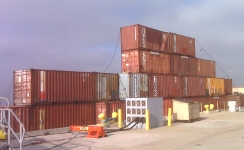
We Have a Winner!
Dan Jaquez, occupational safety & health manager for public works in Ventura County, Calif., for the NAVFAC SW Naval Facilities Engineering Command, won a new ExoFit NEX fall harness in the Capital Safety/OH&S essay contest.
- By Jerry Laws
- Feb 11, 2010
Dan Jaquez has been working to solve a formidable fall protection challenge for about eight months. He hasn't found a solution yet, but at least he's getting a new fall harness for his trouble. Jaquez, occupational safety & health manager for public works in Ventura County, Calif., for the NAVFAC SW Naval Facilities Engineering Command, won a new ExoFit NEX™ fall harness in the Capital Safety/OH&S essay contest.
We invited online visitors to submit a short essay by Jan. 29 describing their biggest fall protection challenge. Capital Safety, which introduced the NEX last fall, judged Jaquez's to be the best entry.
 He described a fall protection challenge involving two crane riggers at a time who must stack shipping containers on a pierside floating platform to a total height of 45 to 60 feet. This job of constructing a target ship for training purposes is done approximately every six months, Jaquez said Feb. 10. The number of containers varies. They are stacked on a platform 80 feet long, one container wide (8-10 feet wide) and four to six containers high. "You're talking about 45 to 60 feet high," Jaquez said.
He described a fall protection challenge involving two crane riggers at a time who must stack shipping containers on a pierside floating platform to a total height of 45 to 60 feet. This job of constructing a target ship for training purposes is done approximately every six months, Jaquez said Feb. 10. The number of containers varies. They are stacked on a platform 80 feet long, one container wide (8-10 feet wide) and four to six containers high. "You're talking about 45 to 60 feet high," Jaquez said.
There are no tie-off points on the containers, which are waterproof and completely sealed. "It's metal, kind of like a corrugated surface. You've got rises and falls, kind of like if you put fiberglass panels over your patio or your roof," he said. "So there's nothing that's inherently built in that they can attach to because even the eyes on the side are used by the crane, and they're also used for the locking mechanism. So they can't tie off to those."
Currently, the work is being done with a crane and a man basket. "It's not our preferred method, but it's what we've got," said Jaquez. "I was hoping [for] something similar to what is offered in the market -- suction devices they use on aircraft wings. But the problem we have is, our surface isn't like an aircraft wing where you've got an expanse of flat metal. We've got six-inch-wide rises and valleys. So I don’t know if there's a company that's devising magnets that will hold 3,000 pounds or 5,000 pounds for a non-certified anchor point."
Not wanting to break the skin of the containers means they are reluctant to install anchor points on them, and in any case, they never know which container is going to go where. Installing anchorages on all would be too costly, even though the containers are reused routinely, he said. Horizontal lifelines are not viable because there is just 6 inches of space between containers when they're stacked, and a lifeline would have to be permanent and yet not interfere with the locking mechanism.
Capital Safety is shipping one of its 1113157 model NEX harnesses to Jaquez this week, and a technical manager for the company is studying his problem to see how it might be solved. He said he wants to find an answer "as soon as possible because I really don't want our people to keep doing it the way they're doing it."
"It's convenient that I won this," he added, "because I need a new harness."
About the Author
Jerry Laws is Editor of Occupational Health & Safety magazine, which is owned by 1105 Media Inc.